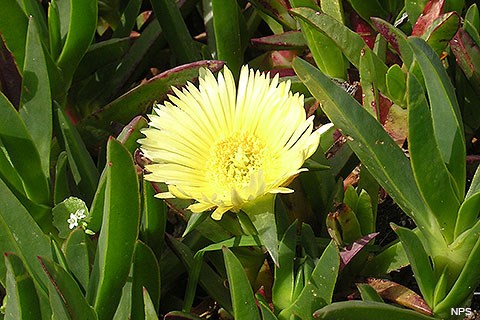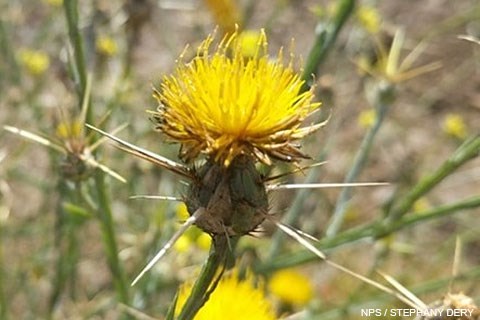Giant Plumeless Thistle (Carduus acanthoides)A large and aggressive plant from Europe and northern Asia, this thistle can grow up to 12 feet tall. It grows rapidly and readily invades disturbed soils. Although it is only found in 2 sites in Marin County, one within Point Reyes, it is classified as a "Class A" noxious weed by the state, and is of highest priority for removal here at the Seashore. 
Iceplant (Carpobrotus edulis)A native to South Africa, this familiar succulent was brought to California in the early 1900s for soil stabilization along railroad tracks. Once established, it spreads quickly by seed and by sending out shoots and roots as it creeps along the ground, forming thick mats that crowd out native species. Iceplant is a tough competitor, surviving in a wide range of soil and moisture conditions, and has invaded fore dune, dune/scrub, coastal bluff scrub, coastal prairie, and coastal chaparral communities all over California. 
ThistlesThere are many species of thistles in California, including natives, harmless exotics, and aggressive invasive exotics. Yellow star thistle (Centaurea solstitialis), purple star thistle (Centaurea calcitrapa), and distaff thistle (Carthamus lanatus) are among the top priority invasives here at Point Reyes. Mainly found in warm, open areas, they can take over grasslands, rangelands, pastures, roadsides, or other disturbed areas. Thistles displace native plants, deplete soil moisture, and decrease land value and forage quality. Yellow star thistle is the most widespread, covering more than 12 million acres in California alone—it can also cause a sometimes fatal neurological disease in horses. Poison Hemlock (Conium maculatum)Brought to the United States in the 1800s as a garden plant, poison hemlock thrives in many habitats. It produces seedlings almost every month of the year, making it a fast growing and highly competitive invasive. Besides crowding and shading out other species, it is toxic, often lethally, to vertebrates if ingested or inhaled. Pampas & Jubata grass (Cortaderia selloana & C. jubata)Extremely difficult to tell apart, these huge bunchgrasses with tall, feathery plumes originated in South America (C. selloana in Argentina, Brazil, & Uraguay, C. jubata in N. Argentina & the northwestern Andes). Although both are commonly referred to as "pampas," C. selloana was brought to California in 1848, and female plants were cultivated for landscaping and planted to prevent erosion in Southern California. It is unclear when C. jubata arrived, but it has become more aggressive and widespread due to its asexual reproduction, not requiring the presence of both male and female plants and pollinators to be successful. A single inflorescence (plume) of either species can produce 100,000 seeds, and there are usually 5–10 (and up to 50!) plumes per plant. Both species are very competitive once established, and large infestations threaten coastal ecosystems throughout California. Cape Ivy (Delairea odorata)Native to South Africa, this vine-link plant can climb 30 feet into trees, and forms dense blankets of vegetation, smothering everything in its path. It is a relatively new escapee into wildlands, but its rapid growth makes it a serious threat to moist areas along California's coast, especially creeks and drainages. It is very difficult to remove completely any piece of stem or root left behind will resprout. Blue Gum Eucalyptus (Eucalyptus globulus)Brought to California from Australia in the 1850s, this species failed expectations of becoming a fast-growing timber crop. Instead, it spread into a wide variety of ecosystems throughout the state, inhibiting native plant growth and threatening local biodiversity by allelopathic chemicals (tannins & phytochemicals) leached from its leaves and litter into the soil. It is most invasive in moist soils and riparian areas, where it intensely out-competes native plants for water. Unpredictable dropping of limbs, large amounts of litter and volatile oils also makes Eucalyptus a dangerous fire hazard. French & Scotch Broom (Genista monspessulana & Cytisus scoparius)These two similar shruby plants of the pea family can be found in almost all types of habitats, often forming impenetrable thickets. Native to Europe and North Africa, their numerous bright yellow flowers are a common sight along roadsides. Individual plants may reach 15 feet tall and live 15 years, producing thousands of seeds per year! Broom is generally difficult to remove because their numerous seeds can remain dormant but viable in soil for decades. English Ivy (Hedera helix)Not dependent on disturbance for establishment, this ivy from Great Britain and the Mediterranean poses a threat to many intact habitats. It forms thick mats on the ground, ousting native plants, and aggressively climbs trees, often killing even the largest trees through shading or nutrient competition. Periwinkle (Vinca major)An attractive groundcover from Switzerland, solid carpets of periwinkle can tolerate a wide range of growth conditions, and can re-root easily after being pulled from the soil. It was introduced as an ornamental plant, and is still sold and used in private landscaping. |
Last updated: September 17, 2021
